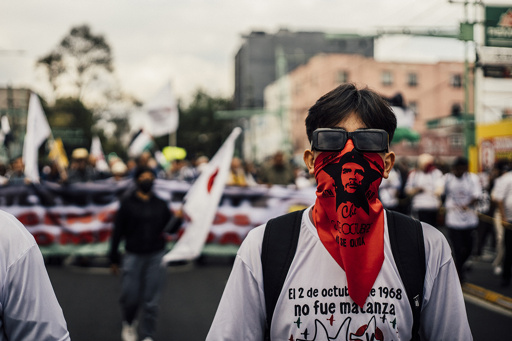This article by Jared Laureles and Alexia Villaseñor originally appeared in the October 2, 2025 edition of La Jornada, Mexico’s premier left wing daily newspaper.
Mexico City. The mobilization marking the 57th anniversary of the student repression in the Plaza de las Tres Culturas in Tlatelolco embraced, among its demands for justice, an end to the genocide against the Palestinian people.
At a rally in front of the National Palace, Félix Hernández Gamundi, former leader of the Student Movement, made it clear that both events constitute genocide.
“Today we have to say that 57 years ago in the Tlatelolco plaza, a massacre did not occur, a genocide occurred, and things must be named properly and by their name in the same way.”

Photo: Jay Watts
“There is no war in Gaza, what there is is genocide, a practice of extermination followed step by step in the most cynical manner by a crazed ruler with fascist and repressive beliefs,” he denounced.
Supported by students, collectives, and social organizations, members of Committee 68 reiterated their demand for justice and reparations.
They pointed out that if the repression of October 2, 1968, had been addressed promptly, “many misfortunes would have been avoided, and many massacres would not have occurred,” including the June 10 Halconazo, the Dirty War, and the attacks against the democratic and libertarian uprising of the Zapatista indigenous people; and the crimes in Acteal, Aguas Blancas, and El Charco.

Photo: Jay Watts
While the rally was taking place, a group from the Black Bloc stormed and attacked members of the now-defunct grenadier corps, who were stationed on the west side of the Zócalo, between 16 de Septiembre and 5 de Mayo.
The group of hooded individuals threw white paint and explosive devices at the police officers, who took cover behind plastic shields; some of these were even taken from them.
The level of aggression was such that some members suffered head injuries and were caught in the fire caused by some homemade explosive devices.

Photo: Jay Watts
Amid the thunderous noise, and to the concern of those attending the march, members of Committee 68 urged people not to fall for the provocations and to remain close to the stage set up in front of the balcony of the National Palace.
“We mustn’t move from here; that’s provocation, and that’s what they’re trying to do to make us panic. There’s no panic here; there’s a will to fight, there’s a will for justice, there’s a will to remain organized to tackle the great tasks before us,” Hernández Gamundi exclaimed.
During his speech, he announced a new action plan for comprehensive reparation for the damages caused by the State in 1968, developed based on the mandates of Mexican and international law.

Photo: Jay Watts
He explained that it contains five points, including truth and justice, punishment for the guilty, reparation for the damage, memory, and a guarantee of non-repetition.
He explained that it’s true, because almost six decades after the student repression, the number of students who died in the Plaza de las Tres Culturas is unknown. And justice, he added, must be pursued because the processes that were initiated must be followed up and those that are “unfinished” must be concluded, because new investigation files must be opened due to new elements.
For example, he explained, the official version of the seizure of the Santo Tomás fortress was that it was carried out by the grenadiers and the police. However, he emphasized, “today there is a document and a series of images showing the Army entering the fortress.”

Photo: Jay Watts
Demanding “Neither forgiveness nor forgetting, punishment for the murderers” and “October 2nd is not forgotten,” the contingent, led by historic leaders of the ’68 student movement, departed from the vicinity of the Tlatelolco Cultural Center and headed toward the capital’s Zócalo. They carried a banner that read: “Silence in the face of genocide is complicity.”
On the Plaza de la Constitución square, members of Committee 68 called for a minute of silence for their fallen comrades, whom they remembered and named one by one, and for the victims of the genocide in Gaza.
They also held the traditional roll call for the 43 Ayotzinapa student teachers who disappeared 11 years ago.
At the end of the rally, some young people lit plastic shields and lit two bonfires in the center of the Zócalo, where the flag is flown at half-mast in commemoration of the 57th anniversary of student repression.

Photo: Jay Watts
Documentary Lachatao Shows Oaxacan Pueblo Struggling to Not Disappear
October 3, 2025October 3, 2025
Filmmaker Natalia Bruschtein’s documentary about the fears and dreams of the children of this small town in the mountains of Oaxaca.
Comité 68: “In Tlatelolco & Gaza, events that constitute genocide.”
October 3, 2025
Supported by students, collectives, and social organizations in a march of thousands in Mexico City, members of Committee 68 reiterated their demand for justice and reparations.
People’s Mañanera October 2
October 2, 2025
President Sheinbaum’s daily press conference, with comments on remembering October 2 1968, President’s first annual report, gas transport safety, action against fuel theft, and amparo reform.
The post Comité 68: “In Tlatelolco & Gaza, events that constitute genocide.” appeared first on Mexico Solidarity Media.
From Mexico Solidarity Media via this RSS feed





